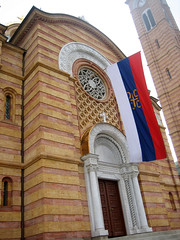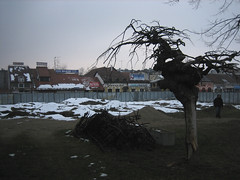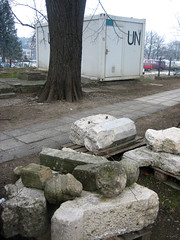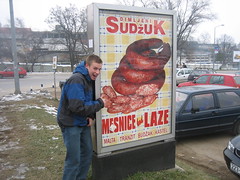Banja Luka
 Last week I took a trip to Banja Luka, the second biggest city in Bosnia and the capital of the Republika Srbska (Serbian Republic), the nation within a state. The RS is officially an "Entity" of Bosnia-Herzegovina, a darkly comical term chosen because it hovers between the too weak "province" and the politically charged "nation." For all intents and purposes, however, going to Banja Luka from Sarajevo is like stepping into another country.
Last week I took a trip to Banja Luka, the second biggest city in Bosnia and the capital of the Republika Srbska (Serbian Republic), the nation within a state. The RS is officially an "Entity" of Bosnia-Herzegovina, a darkly comical term chosen because it hovers between the too weak "province" and the politically charged "nation." For all intents and purposes, however, going to Banja Luka from Sarajevo is like stepping into another country.For one, the road signs change to the Cyrillic alphabet immediately upon crossing the "border," perhaps to confuse nauseating internationals. In reality, the prevalence of the Cyrillic alphabet in the RS is the product of post-war legislation designed to artificially erase as many similarities between the two halves of Bosnia as possible.
For another, the denizens of Banja Luka pay allegiance to a different flag. Take the above photo, for example, which is from the main Serbian Orthodox Church in town. The mosques in Sarajevo only rarely carry a green banner with the crescent and star, but this is at worst an ambiguous symbol for it represents Islam in general. But there is no mistaking the message behind this flag in Banja Luka. It is that of Serbia with the "CCCC" logo on it, which roughly translates to "Only Unity can Save the Serbs." Seeing an enormous national flag flying from a church was a surprise in itself for this Westerner; seeing one national flag in a different country is another; but seeing one emblazoned with an extremely charged nationalistic motto is a step above. I do have to give props to the Serb nationalists -- they never do anything half-heartedly.
Sadly, the desire for a "Greater Serbia" is inextricably intertwined with the Serbian Orthodox Church. The Patriarch Pavle, the Church's holy father, has repeatedly called for the dismantling of the ICTY and the freedom of Karadzic and Mladic, the most wanted war criminals in the world. The infamous Arkan, whose "Tigers" ravaged Bosniak towns along the Serbian border, once called Pavle his "supreme commander."


As for mosques, this is what one looks like in Banja Luka. There were 8 before the war, and they have all been utterly demolished. Having seen plenty of bombed out buildings in Bosnia, you realize that razing an edifice down to its foundations must have taken plenty of dynamite and enormous effort. All that is left of this particular mosque are a few broken tombstones, watched over by a little UN hut. The officials of Banja Luka continue to refuse to grant a building permit to the Muslim community seeking to rebuild. In fact, this mosque was for many years used as a parking lot! By comparison, Sarajevans will tell you with pride that not a single church in Sarajevo was destroyed during the war. Where I live in downtown Sarajevo, you can find a Serbian Orthodox Church, a mosque, a cathedral, and even a synagogue, all within a stone's throw of each other, all many decades old. It may just be the only place in the world like that.
There is not much else to say about Banja Luka, except that I had a great time when I wasn't thinking about war and politics (something which is very hard to do in this country). For example, I highly recommend the club Titanium if you want to experience Euro-trash (with an Eastern Europe twist) at its finest. There is enough hair gel, cigarette smoke, leather, scantily clad women and thumping techno music there, that if you found some way to bottle the club's essence you could probably provide heating to the Ukraine.


I also wish to note two other important things from the trip. 1) There be homies in Bosnia too. 2) Who on earth would find this ad appetizing?
See more photos from Banja Luka and of Jajce too.

0 Comments:
Post a Comment
<< Home